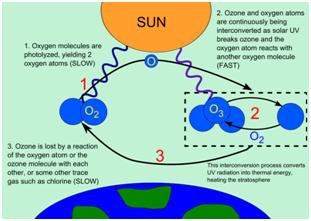The Antarctic ozone hole has closed: World Meteorological Organization (WMO)
- Posted By
10Pointer
- Categories
Environment
- Published
9th Jan, 2021
-
Context
The Antarctic ozone hole - one of the deepest, largest gap in the ozone layer in the last 40 years — has closed.
What is ozone hole?
- An ozone hole is the thinning of the ozone layer boosted in size by colder temperatures.
- Ozone hole is referred to the much larger springtime decrease in stratospheric ozone around Earth's polar region.
- There are also springtime polar tropospheric ozone depletion events in addition to these stratospheric events.
What are the reasons behind the widening of the ozone hole?
- The expansion of the hole was driven by a strong, stable and cold polar vortex and very cold temperatures in the stratosphere.
- The formation of ozone hole in the Antarctic has been an annual occurrence and has been recorded for the last 40 years.
- Human-made chemicals migrate into the stratosphere and accumulate inside the polar vortex. It begins to shrink in size as warmer temperatures dominate.
- The annually occurring ozone hole over the Antarctic had rapidly grown from mid-August and in early October 2020.
- The 2020 Antarctic hole was unprecedented as the polar vortex kept the temperature of the ozone layer cold, preventing the mixing of ozone depleted air above Antarctica with ozone rich air from higher latitudes.

Polar Vortex
- A polar vortex is a wide expanse of swirling cold air
- It is a low pressure area in polar region.
- During winters, the polar vortex at the North Pole expands, sending cold air southward.
|
What is the reason behind the thinning of the hole?
- As the temperature in the stratosphere starts to rise, ozone depletion slows, the polar vortex weakens and breaks down. By the end of December, ozone levels return to normal.
What could be done to reduce the size of the hole?
- It is required to keep enforcing the Montreal Protocol banning emissions of ozone depleting substances (OSD).
- Since the ban on halocarbons, the ozone layer has slowly been recovering, according to WMO.
Montreal Protocol
- The Montreal Protocol is an agreement on Substances that Deplete the Ozone Layer regulates production and consumption of nearly 100 chemicals referred (OSD).
- It is an international treaty designed to protect the ozone layer by phasing out the production of numerous substances that are responsible for ozone depletion.
- It was signed in1987.
|
